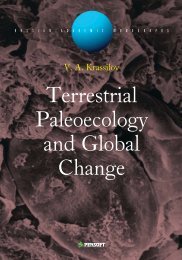EARLY CRETACEOUS FLORA OF MONGOLIA
EARLY CRETACEOUS FLORA OF MONGOLIA
EARLY CRETACEOUS FLORA OF MONGOLIA
You also want an ePaper? Increase the reach of your titles
YUMPU automatically turns print PDFs into web optimized ePapers that Google loves.
Phytostratigraphy<br />
In Mongolia, the Early Cretaceous localities contain sparse fern fragments only while the Jurassic floras are<br />
dominated by ferns. These types of assemblages appear to be easily distinguishable, but the fern criterion needs<br />
further practical corroboration. The fern beds may comprise also the lowermost Cretaceous. Czekanowskia is<br />
abundant in the Jurassic, but has not hitherto been recorded from the Cretaceous.<br />
Four phytostatigraphic units can be provisionally recognized in the Cretaceous:<br />
(1) The Baiera manchurica zone represented at Tsagan-Tsub, Modon-Usu and Bon-Tsagan. Baiera<br />
manchurica is common in the Urgal Formation (Valanginian) of the Bureja basin (KRASSILOV, 1972).<br />
(2) The Otozamites — Pseudolarix erensis zone, comprising the localities Bon-Tsagan, 23—22,Gurvan-Eren<br />
236—29 and Manlaj 2,3 and 92. Apart from Otozamites and Pseudolarix, the correlation of Bon-Tsagan, 23—22,<br />
and Gurvan-Eren is supported by Brachyphyllum sulcatum, while Gurvan-Eren and Manlaj contain the angiosperm<br />
fossils. This community has no close analogues outside Mongolia. The flora is of generalized Wealden<br />
aspect and does not seem younger than Neocomian.<br />
(3) The Baierella hastata (and its cones Karkenia mongolica) — Araucaria mongolica zone includes localities<br />
of the Shin-Khuduk — Anda-Khuduk level, mostly in the paper shale facies at Bon-Tsagan, 73, 74, 75, 87, 193,<br />
194, Kholbotu-Gol 196, 197, 199, 216, Khuriltu, 210, Erdeni-Ula 213, Shin-Khuduk, 1, 117, 118, 119, and<br />
Modon-Usu, 132. Baierella hastata is closely related to B. uninervis (SAMYL.) KRASSIL. from the Tschemchuco<br />
(Aptian) beds of the Bureja basin and Ginkgoites mongolica also represent a leaf morphotype common in the<br />
Tschemchuco beds. Neozamites occurs in the Aptian of Jacutia and Primorye. This community is comparable<br />
with the Aptian flora of Primorye (KRASSILOV, 1967) on account of Araucaria and other conifers.<br />
(4) The Limnothetis-Limnoniobe zone is confined to the Khulsyn-Gol Formation at Bon-Tsagan<br />
45—19. It is destinctive on account of the mass occurrence of endemic cryptogamous plants (new genera).<br />
However the gymnospermous species are the same as in tne third zone, suggesting the age not younger than<br />
Aptian.<br />
Palaeoecology<br />
The Early Cretaceous flora of Mongolia is ecotonal between the temperate (Siberian) and subtropical<br />
vegetation comprising such genera as Phoenicopsis, dominant in the Siberian realm, and Otozamites, typical<br />
representative of the Ptilophylletum communities. Judging by their frequencies, Siberian plants might have grown<br />
on slopes, while subtropical plants dominated the lowland vegetation.<br />
The Mongolian flora differs from both Bureja (temperate) and Primorye (subrtropical) floras by much lower<br />
fern content. Irrespective of their actual frequence in a flora, ferns are rare fossils except in the fern marshes. The<br />
abundance of ferns in the Jurassic localities of Mongolia suggests fairly extensive fern marshes on the deltaic mud<br />
flats. At the beginning of the Cretaceous, the fern marshes had been reduced and the fern fossils became rare.<br />
This happened sumultaneously with the development of meromictic lakes and deposition of seasonal varvites<br />
— the paper shales.<br />
Some reduction of forest vegetation can also be assumed. In the Manlaj localities, conifers are represented<br />
mostly by winged seeds and cone scales. It appears that a conifer forest was at some distance from the lake,<br />
presumably on slopes, while on the flat shores grew the primaeval reed- and sedge-like monocots. They possibly<br />
colonized the mud flats exposed when the lake shranked during a dry season. The appearance of angiosperm<br />
fossils in the lower horizons while they are lacking in the overlain strata, seems paradoxical, but it can be related<br />
to the reduction of indigenous Mesozoic vegetation. A bennettite Otozamites lacustris accompanied them, and<br />
judging by the leaf anatomy (see below), it was adapted to periodical submergence. In Bon-Tsagan, 23—22, the<br />
conifers are better represented, and in Gurvan-Eren, Pseudolarix erensis is most aundant and Brachyphyllum is<br />
also common. The Pseudolaix forest grew perhaps on nearby slopes. An angisperm Gurvanella might also occur<br />
on slopes, because the winged fruits only were fossilized. At the close of the Neocomian, the<br />
Otozamites-angiosperm community was replaced by Baierella-Podozamites shrubs, and the forest vegetation also<br />
underwent considerable changes. Araucaria mongolica and Brachyphyllum densiramosum are abundant in<br />
practically all Aptian localities. They are represented by shoots, microstrobili Williostrohus latisaccus,<br />
Stenomischus sp., megastrobili and seeds (Samaropsis). The conifer forests dominated by Brachyphyllum and

















